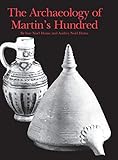The Archaeology of Martin's Hundred : Part 1, Interpretive Studies; Part 2, Artifact Catalog / Audrey Noël Hume, Ivor Noël Hume.
Material type: TextPublisher: Philadelphia : University of Pennsylvania Press, [2016]Copyright date: ©2001Description: 1 online resource (624 p.) : 110 illusContent type:
TextPublisher: Philadelphia : University of Pennsylvania Press, [2016]Copyright date: ©2001Description: 1 online resource (624 p.) : 110 illusContent type: - 9780924171857
- 9781512819717
- 975.54252 23
- F234.M378 N6253 2001eb
- online - DeGruyter
- Issued also in print.
| Item type | Current library | Call number | URL | Status | Notes | Barcode | |
|---|---|---|---|---|---|---|---|
 eBook
eBook
|
Biblioteca "Angelicum" Pont. Univ. S.Tommaso d'Aquino Nuvola online | online - DeGruyter (Browse shelf(Opens below)) | Online access | Not for loan (Accesso limitato) | Accesso per gli utenti autorizzati / Access for authorized users | (dgr)9781512819717 |
Frontmatter -- Contents of Part I -- List of Illustrations -- List of Plates -- Preface -- Introduction -- Chapter 1. The Who, What, When, and Where of Martin's Hundred -- Chapter 2. The People of Martin's Hundred: The Physical Evidence -- Chapter 3. Where They Lived, Worked, Fenced, and Sometimes Hid -- Chapter 4. Arms and Armor in Martin's Hundred -- Chapter 5. Of Pots and Pertinence -- Chapter 6. The Small Finds -- Chapter 7. The Glass -- Chapter 8. The Tobacco Pipes -- Chapter 9. The Pits -- Postscript -- Fronttmatter2 -- Contents of Part II -- List of Figures -- User's Introduction -- Appendix I. Faunal Analyses -- Appendix II. Index of Illustrated Tobacco-pipe Marks -- Appendix III. Cited Excavation Register Entries -- Appendix IV. Ceramic Nomenclature -- Bibliography
restricted access online access with authorization star
http://purl.org/coar/access_right/c_16ec
The Archaeology of Martin's Hundred explores the history and artifacts of a 20,000-acre tract of land in Tidewater, Virginia, one of the most extensive English enterprises in the New World. Settled in 1618, all signs of its early occupation soon disappeared, leaving no trace above ground. More than three centuries later, archaeological explorations uncovered tantalizing evidence of the people who had lived, worked, and died there in the seventeenth century.Part I: Interpretive Studies addresses four critical questions, each with complex and sometimes unsatisfactory answers: Who was Martin? What was a hundred? When did it begin and end? Where was it located? We then see how scientific detective work resulted in a reconstruction of what daily life must have been like in the strange and dangerous new land of colonial Virginia. The authors use first-person accounts, documents of all sorts, and the treasure trove of artifacts carefully unearthed from the soil of Martin's Hundred.Part II: Artifact Catalog illustrates and describes the principal artifacts in 110 figures. The objects, divided by category and by site, range from ceramics, which were the most readily and reliably datable, to glass, of which there was little, to metalwork, in all its varied aspects from arms and armor to rail splitters' wedges, and, finally, to tobacco pipes.The Archaeology of Martin's Hundred is a fascinating account of the ways archaeological fieldwork, laboratory examination, and analysis based on lifelong study of documentary and artifact research came together to increase our knowledge of early colonial history.Copublished with the Colonial Williamsburg Foundation.
Issued also in print.
Mode of access: Internet via World Wide Web.
In English.
Description based on online resource; title from PDF title page (publisher's Web site, viewed 24. Apr 2022)


